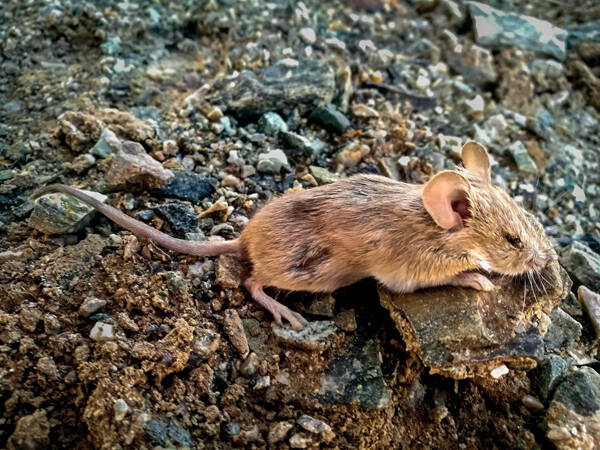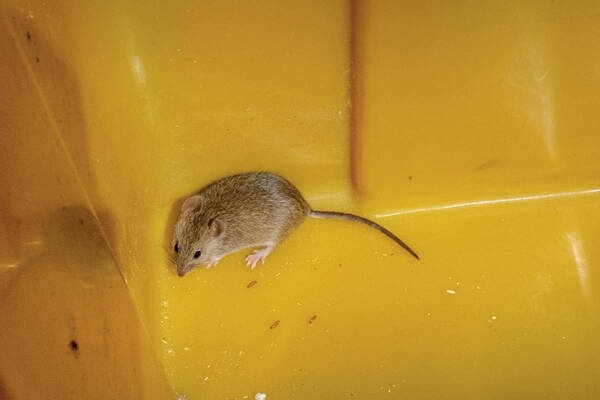Mus musculus
IUCN
LCBasic Information
Scientific classification
- name:Mus musculus
- Scientific Name:Mus musculus,Mouse, rat, little mouse, mickey mouse, domestic deer
- Outline:Rodents
- Family:Rodentia Muridae Rat
Vital signs
- length:60-90mm
- Weight:12~30g
- lifetime:
Feature
The most distinctive feature of mice is that there is a notch on the lingual edge of the upper incisor, which is very obvious when viewed from the side. House mice are no exception.
Distribution and Habitat
It is widely distributed throughout the country. It is also widely distributed abroad, except for the Antarctic Circle, tundra, subalpine primeval forests and alpine bare rocks.
Wherever there are people, there are traces of house mice. Houses, kitchens, warehouses and other buildings, suitcases, kitchen cabinets, threshing floors, wastelands, grasslands, etc. are all habitats of house mice.
Appearance
The individual is small, and the body length generally does not exceed 90mm. The tail length is shorter than the body length, generally about 70% of the body length. The fur color varies in different regions. The northern house mouse is generally lighter in color, while the southern house mouse is darker in color. The back of the northern house mouse is brownish yellow and the belly is white; the back of the southern house mouse is gray-brown or gray. The belly is grayish white, and the base of the fur is light gray. The boundary between the back and belly fur color is usually obvious, but it may not be obvious. The tail is two-colored, light brown on the top and dirty white on the belly.
Details
The house mouse belongs to the Murinae subfamily. The species originated in India and arrived at the Mediterranean coast at the end of the Pleistocene. The time of its entry into my country is unknown. The species is considered to be an unintentional introduction. In Xinjiang, Tibet, Qinghai, and the three northeastern provinces of my country, the wild population is large. There was a major outbreak every five years or so, which was harmful to farmland and threatened human health. In the south, it mainly coexists with humans in houses, but the population is smaller than in the north.

House mouse fossils have been found in only 10 locations in China, including Zhoukoudian Site 1, Jinniushan Site, Zhoukoudian Site 4, Zhoukoudian Donglingzi Cave, Dalian Gulongshan Site, Fox Cave Fossil Site in Qingliu County, Fujian, Longjin Cave Fossil Site in Qingliu County, Yanzi Cave in Jiangle County, and Yanger Cave Fossil Site in Huayuan County, Hunan.
The house mouse is a human companion species with a wide range of habitats. The house mouse is mainly a domestic mouse species, however, reports from different geographical environments and different researchers vary greatly. It has been reported in the literature that a large number of house mice can often be captured in large-scale poultry farms, while the house mice in farmlands and the boundaries of farmlands and pastures often migrate from poultry farms along the river bank. It is reported that in Michigan and other places in the United States, during the period of crop maturity and harvest, due to the induction of abundant food, house mice often frequently move in agricultural farming areas such as sorghum fields, corn fields and soybean planting areas, and especially like to live in the piles of harvested crops. After comparing various geographical landscapes and habitats, scientists found that house mice prefer to live and move in the environment of artificial buildings and artificial landscapes.
The house mouse has a habit of migration. When the weather warms up in March and April every year and spring sowing begins, they move from houses and warehouses to farmland, and in autumn they gather in farmland where crops are ripe. After the crops are harvested, they also move to threshing grounds and under grain stacks, and then move into houses and warehouses as grain is stored.
The house mouse is an omnivore, but it mainly feeds on plant-based food, especially flour and pasta. They like to eat all kinds of grains and oil seeds. In early spring, they also eat wheat seedlings, tree bark, vegetables, etc. In apple storage warehouses, they hide during the day and come out at night, running around everywhere, and they are very destructive to plastic bags, small packages, cartons, etc. Sometimes they eat small seeds and insects. They have a small appetite and are not strict about the moisture conditions of food.
The house mouse is active during the day and night, but mainly at night, especially at dawn and dusk, forming two obvious activity peaks.

House mice live in groups. The male leader will form a family with several females in his territory and live with their offspring; sometimes there will be disputes over territory between males. It is rare to see fighting between a family of house mice, but they will unite to resist strange outsiders.
The house mouse is very fertile and can reproduce all year round, although wild mice may only have a breeding season from April to September; the reproduction rate is higher in spring and autumn, and lower in winter. House mice can generally reproduce all year round, and they can reach sexual maturity when they weigh 7 grams. The estrus cycle is 4-6 days and lasts less than a day; females will experience an estrus period of up to 12-18 hours after giving birth. Each litter can generally produce 5 to 8 pups, or even up to 14 pups. The gestation period is about 20 days, but if the female is breastfeeding, it may be extended for several days; 6 to 8 litters can be produced in a year, with 4 to 7 pups per litter. Newborn mice can reach sexual maturity and participate in reproduction in the same year. Generally, they can live up to two years old, but some house mice can live for more than four years; the life span of wild house mice is 12 to 18 months.
House mice harm all crops and steal food. The main harm period is the harvest season. When harming, they generally do not bite off the plants, but only steal the ears of grain, and the affected plants rarely fall down. The harm in residential areas is very serious, and they are omnipresent, often biting clothes, food, furniture, books, and other household items can be destroyed and contaminated by them. At the same time, they enter and exit human residences in large numbers, which can spread certain natural epidemic diseases.
The special feature of the house mouse is not its morphology, but its strong ecological adaptability, which makes it difficult for general de-ratification methods to work. Its strong ecological adaptability is mainly manifested in: omnivorous; diversified movement methods, able to run, jump, and climb; low nesting conditions, can live in wall holes and cracks, and can also nest and reproduce in clothes, furniture, sundries and haystacks; activity patterns and rhythms can change quickly with environmental conditions; although it is thermophilic, it has a strong ability to chemically regulate temperature and can tolerate lower temperatures. In addition, its feeding behavior is intermittent, and the amount of food taken each time is very small, which brings certain difficulties to de-ratification with poison bait.
In the wild, house mice have natural enemies all over the world, including cats, foxes, weasels, stoats, ferrets, lizards, snakes, eagles, falcons, owls, etc. On the basis of drug control of rodent pests, increasing the number of natural enemies of house mice, such as hawks attracting hawks and releasing sand foxes, is an effective way to control rats.
House mice are the ancestors of today's experimental mice. The experimental mice currently used, such as white mice, are mainly domesticated and bred from house mice. House mice have some similarities with humans in genetic characteristics, and they grow and reproduce quickly, are easy to breed, and have low breeding costs. In medical scientific research, house mice are often widely used as models of human diseases. In 1902, William Emest Castle of Harvard University's Busey Institute first used house mice as a research object for genetic variation-related research, allowing house mice to officially enter the laboratory from pet farms. At present, there are many strains of experimental mice domesticated and bred from house mice, which are divided into inbred strains (pure strains), mutant strains, hybrid first generation, and closed groups (outbred groups) according to their genetic characteristics. Because inbred mice have the advantages of consistent genotypes and genetic characteristics, small differences between individuals, and consistent reactivity, they have become one of the ideal experimental materials for modern medical scientific research.
Listed in the 2008 IUCN Red List of Threatened Species ver 3.1 - Least Concern (LC).








